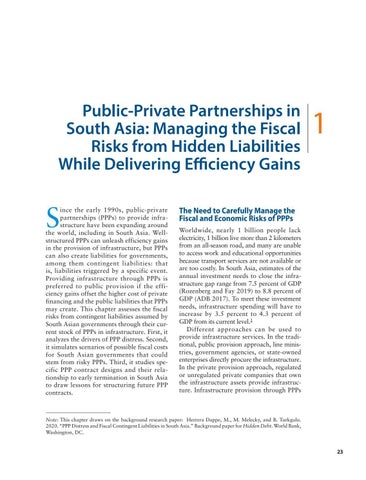Public-Private Partnerships in South Asia: Managing the Fiscal Risks from Hidden Liabilities While Delivering Efficiency Gains
S
ince the early 1990s, public-private partnerships (PPPs) to provide infrastructure have been expanding around the world, including in South Asia. Wellstructured PPPs can unleash efficiency gains in the provision of infrastructure, but PPPs can also create liabilities for governments, among them contingent liabilities: that is, liabilities triggered by a specific event. Providing infrastructure through PPPs is preferred to public provision if the efficiency gains offset the higher cost of private financing and the public liabilities that PPPs may create. This chapter assesses the fiscal risks from contingent liabilities assumed by South Asian governments through their current stock of PPPs in infrastructure. First, it analyzes the drivers of PPP distress. Second, it simulates scenarios of possible fiscal costs for South Asian governments that could stem from risky PPPs. Third, it studies specific PPP contract designs and their relationship to early termination in South Asia to draw lessons for structuring future PPP contracts.
1
The Need to Carefully Manage the Fiscal and Economic Risks of PPPs Worldwide, nearly 1 billion people lack electricity, 1 billion live more than 2 kilometers from an all-season road, and many are unable to access work and educational opportunities because transport services are not available or are too costly. In South Asia, estimates of the annual investment needs to close the infrastructure gap range from 7.5 percent of GDP (Rozenberg and Fay 2019) to 8.8 percent of GDP (ADB 2017). To meet these investment needs, infrastructure spending will have to increase by 3.5 percent to 4.3 percent of GDP from its current level.1 Different approaches can be used to provide infrastructure services. In the traditional, public provision approach, line ministries, government agencies, or state-owned enterprises directly procure the infrastructure. In the private provision approach, regulated or unregulated private companies that own the infrastructure assets provide infrastructure. Infrastructure provision through PPPs
Note: This chapter draws on the background research paper: Herrera Dappe, M., M. Melecky, and B. Turkgulu. 2020. “PPP Distress and Fiscal Contingent Liabilities in South Asia.” Background paper for Hidden Debt. World Bank, Washington, DC.
23

